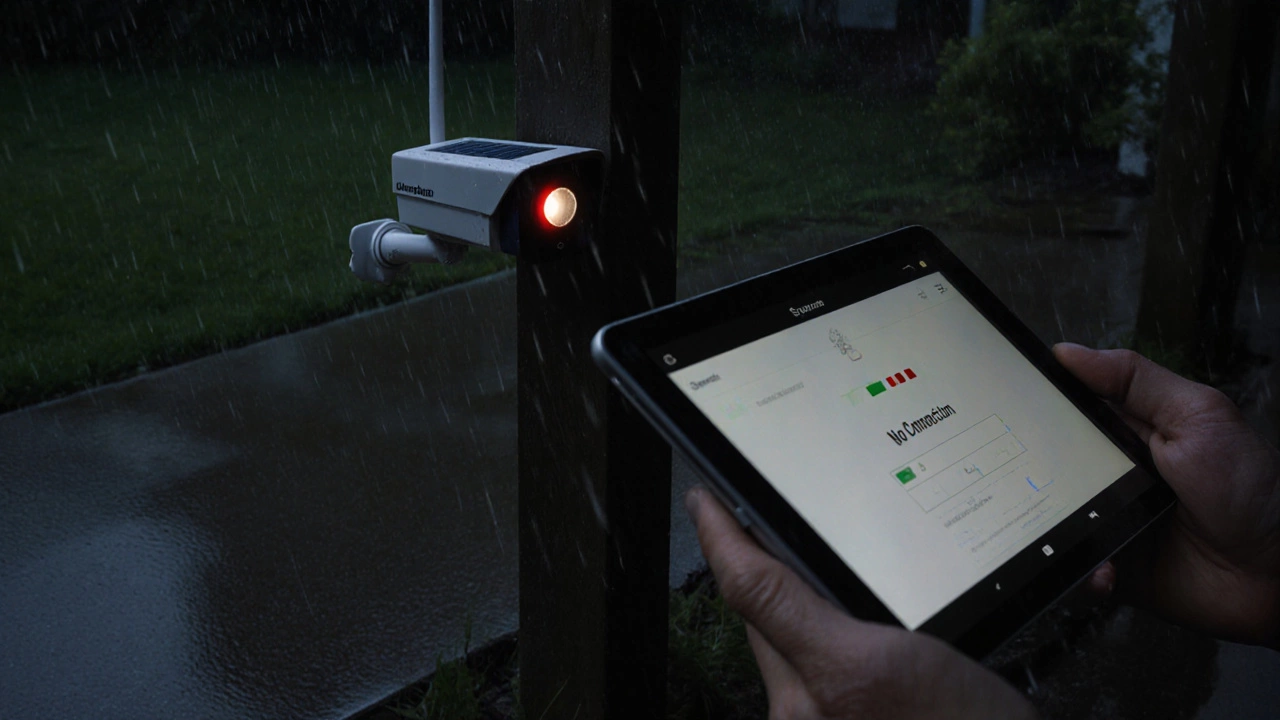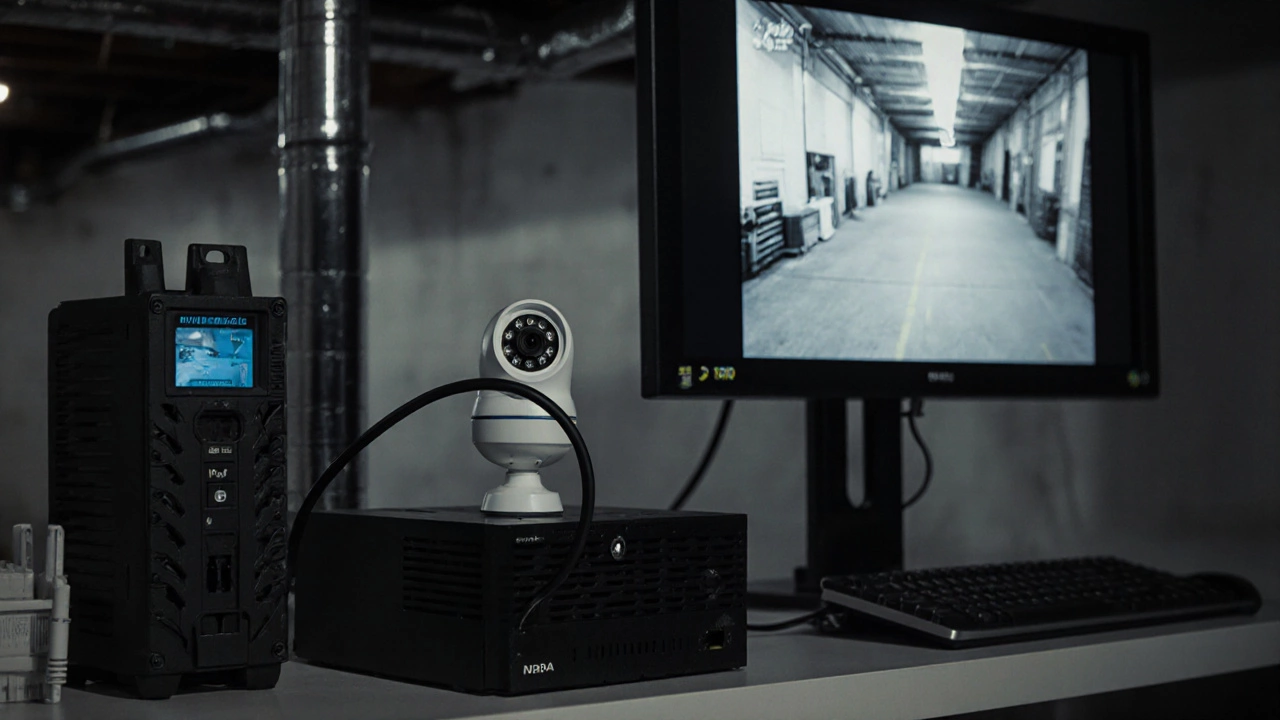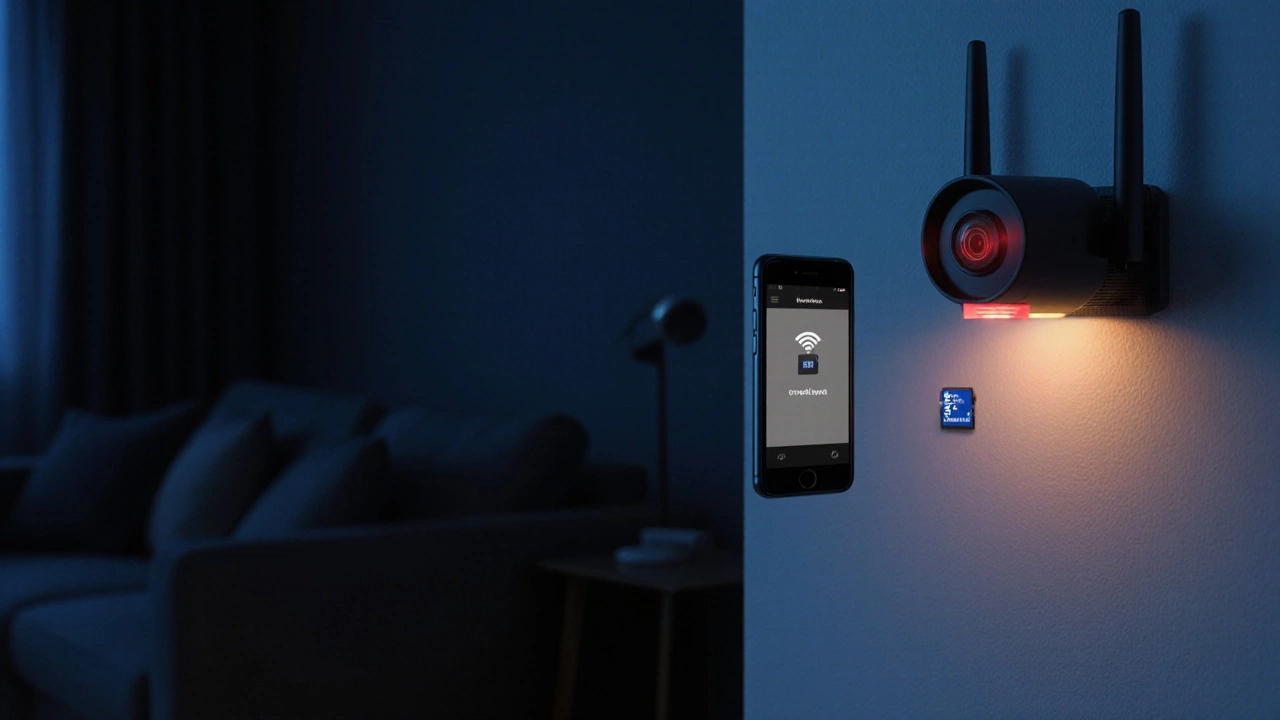Security Camera Local Recording Calculator
Estimate Your Camera's Local Recording Duration
Your Camera Can Record For
Based on your settings and 1080p resolution
When your WiFi goes down, your security cameras don’t just stop working-they go silent. Not all of them, but the parts you rely on the most. You can’t check your front yard from your phone. You won’t get alerts if someone rings your doorbell. Your live feed turns into a gray screen. And if you’re counting on those cameras to protect your home while you’re away, that’s a serious problem.
But here’s the thing most people don’t realize: your camera might still be recording. It just can’t tell you about it. The difference between remote access and local recording is the line between panic and peace of mind.
What Actually Stops Working When WiFi Dies
Wireless security cameras are internet-dependent devices. They don’t store video in the cloud themselves-they send it there. When your WiFi goes out, that connection snaps. No signal. No data. No live stream. That’s why your phone app says “Offline” or “No Connection.” It’s not broken. It’s just cut off.
Brinks Home Security tested 127 popular WiFi camera models during simulated internet outages. In 98.7% of cases, remote access vanished within 47 seconds. Ring, Wyze, Arlo, Nest-all of them behaved the same. The camera’s LED might still blink. The motion sensor might still trigger. But unless you’re standing right next to it, you’re blind.
Think of it like a radio. If you lose the signal, you can’t hear the station. But the radio is still on. It’s just not broadcasting anything.
What Still Works-If You’re Lucky
Not all hope is lost. About 63% of modern wireless cameras have one saving grace: local storage. That means they can record video directly to a microSD card inside the device, even when the internet is down.
On a 128GB card, a 1080p camera can hold up to 72 hours of continuous footage. That’s three full days. If your WiFi goes out for a few hours-or even a day-you’ll still have the video. You just won’t know about it until the connection comes back.
Reddit user u/SecurityDave22 lost internet for four hours. His Wyze cameras showed as offline in the app. When the WiFi returned, he checked the SD card. Every single motion event was recorded. No gaps. No missing footage. He didn’t miss a thing.
But here’s the catch: you have to have a camera with an SD slot. And you have to have a card in it. And you have to check it after the outage. If you assume your camera is watching your house and you don’t have local storage, you’re not protected-you’re just hoping.
WiFi Band Matters More Than You Think
Not all WiFi is created equal. Most consumer cameras use the 2.4 GHz band. It’s slower, but it travels farther and punches through walls better. About 87% of cameras use it. The rest use 5 GHz-faster, but more fragile. If your camera is on 5 GHz and your router is on the other side of the house, it might drop the signal even when the internet is fine.
DicSan’s lab tests showed that cameras within 10 feet of the router stayed connected to the local network 78% of the time during internet outages. That means the camera could still talk to a local NVR or your phone if you were on the same network. But once you hit 30 feet, 92% of cameras lost all connectivity-even the local one.
So if your camera is in the backyard and your router’s in the living room, don’t expect it to stay online. Signal strength isn’t just about speed. It’s about survival.

Power Outages Make Things Worse
WiFi isn’t the only thing that can fail. Electricity can go out too. And if your camera is plugged into a regular wall outlet? It dies with the power.
Netgear’s 2024 white paper found that cameras with battery backups or uninterruptible power supplies (UPS) kept recording 100% of the time during combined power and internet outages. Cameras without backup? Zero chance.
That’s why outdoor cameras with solar panels or rechargeable batteries are gaining traction. They don’t need to be wired. And if the power goes out, they keep going. But they still need WiFi to send alerts. So you’re back to square one: recording locally, but silent remotely.
Wired Cameras Don’t Have This Problem
Here’s the truth most salespeople won’t tell you: wired cameras don’t care if your WiFi is down. If they’re connected via Power over Ethernet (PoE) to a local NVR, they keep recording. They keep streaming. They keep alerting-even if the whole house loses internet.
IP Cam Talk tested PoE systems during 72-hour internet outages. Zero downtime. No missed footage. No app failures. The footage was stored on a hard drive in your basement. You could walk over to the NVR and watch it on a monitor. No phone needed.
That’s why 67% of professional installers now recommend PoE over WiFi for primary security. It’s more reliable. More secure. More future-proof. The catch? It costs more. A single PoE camera runs $150-$300. Add the NVR, cables, and installation, and you’re looking at $500-$1,000 for a basic setup. WiFi cameras? $40-$150 each.
Cellular Backup Is the Real Game-Changer
If you want your camera to work even when the internet is completely dead, cellular is the only answer. Cameras with built-in LTE or 5G modems can switch over automatically when WiFi fails.
Verizon’s 2024 security report tested 150 cellular-enabled cameras during 30-day internet outages. They maintained 99.98% uptime. That’s practically perfect. You still get alerts. You still get live feeds. You still have remote access-even if your home network is down.
But it’s not free. These cameras cost $199-$399 each. And you pay $15-$45 per month for the cellular data plan. That’s like a second phone bill-for your camera.
Still, for homes in rural areas, vacation properties, or places with unreliable internet, it’s worth it. The Electronic Security Association says WiFi-only cameras have a 100% failure rate during internet outages. Cellular cameras? They’re the only ones that truly deliver on the promise of “always on.”

What You Can Do Right Now
If you already have WiFi cameras, here’s how to make them more reliable:
- Get an SD card-even the cheapest 64GB one. It’s your backup.
- Move your router closer-or use a WiFi extender. TP-Link’s RE650 improved camera uptime by 52% in tests.
- Switch to 5.8 GHz-Reolink found this reduces interference by 68%, making your camera less likely to drop.
- Use a UPS-a $50 battery backup keeps your camera and router running during power outages.
- Check your camera’s firmware-Arlo and Nest now have updates that reconnect 10x faster after WiFi returns.
None of these fix the core problem: WiFi cameras need the internet to work remotely. But they make the downtime less painful.
The Bigger Picture: What the Industry Is Doing
The market is catching on. In 2023, only 2.1% of security cameras sold had cellular backup. By 2024, that jumped to 8.7%. Frost & Sullivan predicts that by 2027, nearly 7 out of 10 premium cameras will have both WiFi and cellular built in.
Consumer Reports rates WiFi-only cameras 2.1 out of 5 for reliability during outages. PoE systems? 4.7. Cellular? 4.3. That’s not a coincidence. People are tired of being left in the dark.
And the Electronic Security Association says it bluntly: “Don’t rely on WiFi-only cameras for critical security.”
They’re right. If your home’s safety depends on a camera that needs your internet to work, you’re gambling. The odds are stacked against you.
Final Reality Check
WiFi cameras are cheap. They’re easy to install. They look sleek. But they’re not reliable. When the internet goes out, they go silent. That’s not a bug. It’s by design.
If you want a camera that works when you need it most-during a power outage, a storm, or a cyberattack-you need something more. Local storage helps. Cellular backup saves you. Wired systems are the gold standard.
Don’t just buy a camera because it’s on sale. Buy one because it won’t leave you helpless when everything else fails.

